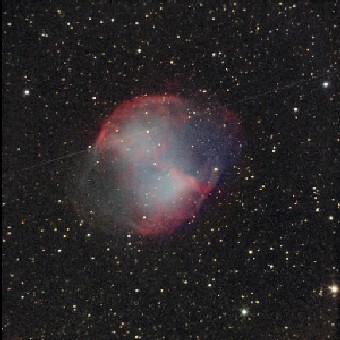
On August 13, 2006, at 3:14:10 UT (11 pm EDT), Don Parker captured a Perseid meteor crossing the Dumbbell Nebula in a 60-minute RGB exposure (the meteor was captured in the green exposure) through a 10" f/11 Takahashi Mewlon, ST-9XE telescope.
The reports are in! Despite a waning gibbous Moon on the evening of August 12th, the Perseid meteor shower did not disappoint. Between twilight and moonrise, observers from dark country skies reported up to 20 “shooting stars” an hour — a meteor every three minutes — some fast and blip-like, some slow and spectacular.
Under ideal conditions, the Perseids can produce 60 meteors per hour at their peak. This year, the International Meteor Organization (IMO) predicted maximum activity for obervers between 23:00 and 1:30 Universal Time (7:00 to 9:30 p.m. Eastern Daylight Time) on August 12 – 13. This time period overlapped sufficiently with the dark evening skies between sunset and moonrise on the east coast of the US to enable a good hour of Moon-free observing. However, even under ideal dark conditions, many global reports from the North American Meteor Network and meteorobs placed the average rate at around only 20 meteors per hour.
For viewers in the northeastern US, local twilight ended around 24:45 UT (8:45 p.m. EDT), so lingering daylight disrupted the peak more than moonlight did. Until the Moon rose around 2:10 UT (10:10 EDT), the Perseids performed as if on cue. Looking for meteors after moonrise is a bit like looking for fireflies under the glare of a floodlight. Unless you can block the glare behind a building or bank of trees, much of the dim streaks and flashes are washed out. Even after moonrise and past the peak, diligent observers who braved the Moon's glare were awarded with dozens of bright meteors throughout the course of the evening. Global observer logs reported many memorable fireballs, defying the washed-out sky.
In spite of the lackluster reports, the Perseids are a gem for other reasons: as the brightest shower of the summer, they consistently offer wholesome entertainment on (relatively) temperate August evenings. This year, a Saturday “primetime” peak made it particularly convenient for many viewers.
Several other concurrent meteor showers added to the Perseids meteor count, producing sporadic meteors whose paths did not trade back to the Perseus radiant. The Delta Acquarids, Alpha Capricornids, and Kappa Cygnids are concurrent showers with broad peaks over several weeks in July and August that may have accounted for many sporadics that added to the show.
If you missed the Perseid performance, don’t fret — any clear summer evening offers a good chance for continuing sporadic meteors. However, save the date for the next potential “show”: the Leonids, for which a possible resurgence in the zenithal hourly rate to 100+ is predicted for November 19, and the Geminids with a peak zenithal hourly rate of 120 expected on December 14. For a calendar of meteor showers, visit the North American Meteor Network at www.namnmeteors.org.
 0
0
Comments
You must be logged in to post a comment.